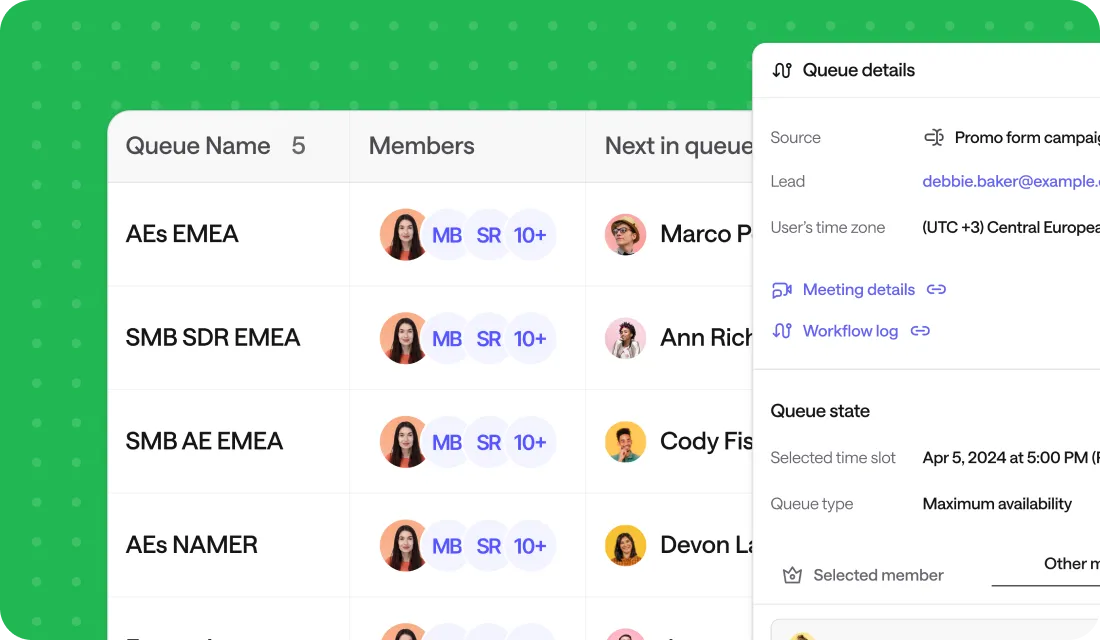Try Default

See how revenue teams automate revenue operations with Default.

Key Takeaways
Although inbound marketing has been around since as early as 1845 with Tiffany & Co.’s famous “Blue Book,” it achieved new popularity among internet marketers around 2006. At the time, the chief evangelist of this “revolutionary” approach to marketing was HubSpot. Now, there are so many software options that GTM and RevOps orgs have their pick of the best inbound marketing tools.
If you want to know which solution is best for your inbound marketing strategy, continue reading for our review of the top seven tools on the market.
The best inbound marketing tools, at at glance
1. Default: Best all-in-one inbound marketing tool
2. HubSpot: Best inbound marketing CRM
3. SEMRush: Best inbound marketing tool for SEO
4. Apollo.io: Best inbound marketing tool for customer intelligence
5. Klaviyo: Best inbound marketing automation for eCommerce
6. Buffer: Best inbound marketing social media tool
7. Webflow: Best inbound marketing CMS
What are inbound marketing tools?
Inbound marketing is all about being present where your potential customers are—search engines, ads, email, social media, third-party partnerships, etc.—converting leads at the top of the funnel, then leveraging marketing automation tools to nurture them into customers:
You can learn the difference between inbound marketing qualified leads vs sales qualified leads <--- in our guide, here.
1. Default: Best all-in-one inbound marketing tool

Over the course of this article, we’ll be covering a number of the best inbound marketing tools for individual use cases. However, if you want to support your inbound marketing campaigns without broken integrations and revenue leakage, Default is the best option.
Key features
- Real-time, automated lead distribution based on real-time enrichment, captured data, CRM insights, and behavioral data from your PLG funnel
- Automated scheduling at the point of conversion to increase response rates from potential customers
- Drag-and-drop, no-code workflows with a range of advanced customizations
- Deep integrations and orchestration capabilities for your underlying tech stack
Pricing
All Default pricing tiers include unlimited meetings, forms, and routing. The Essential tier includes 250 enriched leads per month and five seats. The Growth tier, perfect for fast-scaling companies, includes 1,000 enriched leads per month and 10 seats. The Enterprise tier for large-scale inbound traffic includes unlimited enriched leads per month and 20+ seats.
Pros
- All-in-one platform that reduces siloes, broken touchpoints, data loss, and revenue leakage
- Simple, intuitive UI—no coding or engineering expertise to build lead distribution flows
- Orchestration layer for more complex tech stacks
- Behavior-based lead distribution (e.g. such as unattended leads or lack of engagement)
- Automatic, real-time lead enrichment from Clearbit and Apollo
- Qualification, routing, and automations are unlimited starting with the base level plan
Cons
- Not a point solution
- Built for ease-of-use and not a technical user base
See the full scope of Default’s inbound marketing capabilities—check out our workflow templates here.
2. HubSpot: Best inbound marketing CRM

When you say “inbound,” the first brand that comes to mind is probably HubSpot—the first mover in the space. If you’re looking for a CRM that integrates seamlessly with other inbound functionality, you’ll want to give HubSpot a look.
Key features
- CRM integrates with various inbound touch points—enabling a comprehensive “feed” of lead and potential customer activity
- Form and landing page builders for capturing inbound leads
- Built-in lead scoring, workflows, and automations to qualify, route, and assign inbound leads
- Email campaigns & automations for both marketing and sales nurture
- Customized dashboards for high-level and granular reporting
Pricing
HubSpot has a complicated pricing structure based on the user’s specific needs. The HubSpot CRM starts completely free, and then you can add the Marketing Hub, Sales Hub, and Service Hub as needed. You’re also charged based on the number of “marketing contacts” you keep in the database, and it can be difficult to remove bad leads to keep that number down and avoid up-charging.
Monthly pricing ranges from $20 to $3600 per month, depending on features, users, contact database size, and add-ons.
Pros
- Built from the ground up to support inbound marketing campaigns
- Centralized database that provides a common data foundation for your inbound marketing automations
- Scalable pricing that grows with your organization
- Highly sophisticated analytics and reporting that integrates with Google Analytics
Cons
- Workflows are limited in their functionality and are difficult to customize
- The platform can be unwieldy and complex, especially for early-stage businesses
- Automations and workflows are unavailable with the Starter package and require additional spend
- Can quickly become business-critical, making it difficult to replace
How does Default stack up against HubSpot? Read our official comparison guide on Default vs Hubspot
3. SEMRush: Best inbound marketing tool for SEO

SEO is a critical part of your inbound marketing efforts. As buyers actively search for solutions to their problems, you need to position your content to answer their questions and drive them to your website.
But SEO is constantly evolving. An SEO tool that identifies high-value keywords and provides guidance on generating content that ranks is an absolute must for any inbound marketing stack. Let’s walk through why SEMRush is an excellent choice for inbound marketing SEO.
Key features
- Keyword research tools to identify search volume, buying intent, and top competitors to better understand your target audiences
- Competitor analytics to provide guidance for writing high-performing content
- On-page SEO advice to increase content ranking
- Live rank-tracking so you can see progress happen in real time, which is more powerful than what Google Analytics offers
- Link building tools to help strengthen your domain authority and backlink profile
Pricing
SEMRush offers three pricing tiers. Below are the monthly rates. Users can earn a 17% discount by paying annually.
- Pro—$135.95 per month. This tier is built for beginners and small teams, offering the ability to track 500 keywords and produce 10,000 results per report. Included features: competitor analysis, keyword research, backlink analysis, and more.
- Guru—$249.95 per month. This tier is built for agencies and growing companies, offering 15 projects and the ability to track 1,500 keywords and generate 30,000 results per report. This tier also includes content marketing features, as well as multi-device and location tracking.
- Business—$499.95 per month. This enterprise tier enables you to track 5,000 keywords and generate 50,000 results per report.
Pros
- Powerful analytics that answer nearly all relevant SEO questions
- Handles multiple accounts well and enables comprehensive deep dives of all assets
- Saves time in competitive research by compiling relevant content instantly
Cons
- The starting price point may be too high for many small businesses
- It’s easy to be overwhelmed by the platform’s robust functionality—especially if you’re not an SEO expert
- Some users complain that estimated traffic estimates tend toward the higher side
4. Apollo.io: Best inbound marketing tool for customer intelligence

Key to effective inbound is knowing who your target audiences are and which topics and interests best engage them. That requires data. And when it comes to customer intelligence data, one of the top platforms on the market—and a Default data partner—is the lead enrichment software, Apollo.io.
Key features
- Comprehensive database with 200M+ contacts and 60M+ companies
- A wide range of demographics and behavioral signals to build hyper-personal target audiences
- Customizable email, LinkedIn, and cold call sequences built directly into the platform
- Compatibility and integrations with the majority of Customer Relationship Management (CRM) platforms
Pricing
Apollo.io’s credit-based pricing structure breaks down into four tiers. The Free tier offers unlimited email credits and limited lead routing and sequencing. The Basic tier ($49 per month) offers significantly higher export capabilities and performance tracking. The Professional tier ($79 per month) includes advanced reports & dashboards and limited AI assistance. Finally, the Organization tier ($149 per month) expands Apollo’s AI capabilities and enables advanced security and API functionality.
Pros
- Simple, intuitive UX/UI
- Up to 10,000 free leads right out of the gate
- Powerful filters to drill down and build targeted prospect lists to improve lead distribution efforts
Cons
- Some users have reported trouble getting past spam filters
- Questions around reporting accuracy
- Sluggish customer support
- No built-in forms
- Some steps in the buyer journey require manual intervention
See Apollo.io’s G2 reviews here.
5. Klaviyo: Best marketing automation point solution

With a range of templates, segmentation options, and reporting, Klaviyo is a top choice for a marketing automation point solution. Although it lacks all the capabilities necessary for supporting your inbound marketing effort, its powerful capabilities make it a leader in its category, which is why we’ve included it in this roundup.
Key features
- Multi-channel marketing automation support, including email, SMS, mobile push notifications, reviews, and web forms
- Customer segmentation powered by real-time data
- Automated workflows that start with 60+ templates and allow full customization
- Comprehensive reporting dashboards to enable visibility into workflow performance
Pricing
Klaviyo’s pricing depends on your active monthly email sends. It’s free for the first 500 sends. The lowest monthly plan we found was $20 per month, with the top tier coming in at $2,350 per month for up to 250,000 monthly email & SMS sends.
Pros
- Customizable workflows enable a quality user experience personalized based on real-time data
- Out-of-the-box workflow templates make it easy to get started
- Ability to drive customer engagement through personalized replies to inbound email and SMS messages
Cons
- The platform only handles workflows and automations, not the entire inbound journey
- The user experience is difficult and causes friction for some users
- Performance slows as you use more data to filter the campaigns
- Some users have concerns about the platform’s security and customer support
Read Klaviyo’s G2 reviews right here.
6. Buffer: Best inbound marketing tool for social media

A key aspect of any inbound marketing campaign is meeting your customers wherever they are online—and one of those locations is social media. Buffer offers a comprehensive social media toolkit with everything you need to automate content, track engagement, and build your online presence.
Key features
- Create social media posts within the app itself—no need for jumping back and forth between documents
- Publish content across all your social media platforms and automate future posts with a built-in content calendar
- Engage with comments, replies, and messages directly within the app
- Analyze performance to improve future campaigns and create even more valuable content
- Customized landing page builder to capture contacts that come in from social media
Pricing
Buffer breaks down their pricing into four tiers:
- Free. Connect up to three channels, publish and plan content, and build basic landing pages.
- Essentials—$6 per month per channel. Adds engagement and analytics tools.
- Team—$12 per month per channel. Adds unlimited team members and clients and draft collaboration tools.
- Agency—$120 per month for 10 channels. Adds custom access and permissions.
Pros
- Intuitive UX/UI that makes it easy to get your content out there
- Calendar view helps ensure full-day coverage across all your social media channels
- Responsive customer support
Cons
- While Buffer is great at attracting new inbound leads, it doesn’t handle any post-conversion activities
- Some users complain about bugs (e.g. links that don’t shorten) popping up periodically
Read Buffer’s G2 reviews here.
7. Webflow: Best inbound marketing CMS

The lynchpin of any inbound marketing flow is your content management system (CMS). This is the magnet that attracts your inbound traffic, where you provide helpful, relevant information and drive them to convert. Webflow is a responsive CMS that enables custom websites without requiring a single line of code—and it’s the platform we use here at Default!
Key features
- Real-time, visual website builder that doesn’t restrict you to a single theme
- Interactive tools that enable immersive experiences for users
- Localization tools that enable hyper-targeted personalization
- Built-in SEO features to enable organic growth
- Integrates with Google Analytics for site performance tracking
Pricing
Webflow comes in five tiers. The Free tier works for hobby sites and offers no custom domains. The Basic tier offers a custom domain, up to 150 pages, 500 monthly form submissions. The CMS tier is designed for blogs and content-based sites, and expands form submissions to 2,000 per month. Then there are the Business and Enterprise tiers, which expand features to include additional pages, content, submissions, and advanced security features.
Pros
- User-friendly interface with a low learning curve
- A great tool for marketers without much coding experience
- Great ongoing support and customer education resources
Cons
- Limited form submissions on paid plans, which can limit your inbound growth
- Handles front-end content well, but lead capture forms must integrate with back-end automations and workflows
Read Webflow’s G2 reviews here.
How to choose the best inbound marketing software
So how do you choose the best inbound marketing software for your organization’s needs? Here are a few tips to make sure you’re making the right investment.
Have a clear objective
What are you hoping to achieve with your inbound marketing tools? What functions will they accelerate or automate (or both)? How are you going to measure return on investment? Having clear answers to these questions will help you sift through the available options.
Functionality vs. ease of use
In most cases, inbound marketing platforms with the most advanced features and functionality end up being the most unwieldy to use. While there are certainly exceptions (like Default), it’s important to understand which is a bigger priority for your team size, structure, and technological aptitude.
Budget
Obviously, you shouldn’t spend money you don’t have. Knowing your budget and doing some research in advance can help avoid hours of wasted time on sales calls.
Reviews and reputation
Use sources like G2 and Capterra to find out what these products’ users have to say about them. These reviews can offer a clear window into whether the marketing language on the companies’ websites matches the experience you’ll get if you choose these platforms.
Inbound marketing software FAQs
How many inbound marketing tools do I need?
Ideally, as few as possible. The more platforms you try to integrate and automate, the higher your chances of broken integrations, slowdowns, and lost or corrupted data. Remember: the slower and more error-prone your inbound flows, the less likely you are to book meetings.
What if I have a significant number of inbound marketing tools that my team loves?
To avoid breakdowns and open the door to advanced automation capabilities, you’ll need a common orchestration layer to coordinate and manage the data and automations across the board. Default provides this powerful functionality—see some examples of what we can do through these workflow templates.
What’s the ideal inbound marketing tech stack to optimize speed-to-lead?
You need an all-in-one inbound marketing tool that captures, enriches, qualifies, routes, schedules, and nurtures leads all from one central location. Default is the only platform that performs all these functions seamlessly and automatically from a single platform.
Learn more in our guide on the best lead qualification software.
Accelerate your inbound marketing success with Default

You can attract all the inbound traffic in the world, but without a seamless, automated conversion path, you risk missing out on key business opportunities. Default is the best inbound marketing tool for capturing, converting, and closing inbound leads because it seamlessly integrates all the functionality you need within one platform. No integrations needed.
The business case for Default is clear. Our customers have increased qualified demos by 200% and speed-to-lead by 67% by using us to support their digital marketing campaigns.
Ready to see Default in action? Schedule a demo with our team here.
Conclusion

Former pro Olympic athlete turned growth marketer. Previously worked at Chili Piper and co-founded my own company before joining Default two years ago.
Run revenue as an engineered system
Revamp inbound with easier routing, actionable intent, and faster scheduling














.png)

























